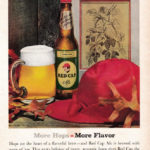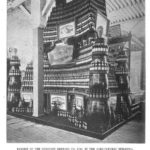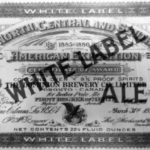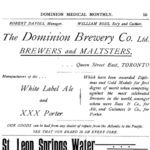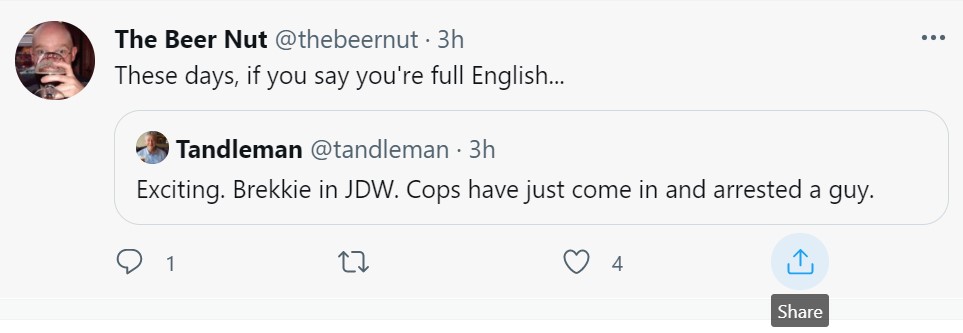 Crickety chirp chirp. Not necessarily in the beer world but certainly in this part of Canada. Holiday long weekend leading into the first week of a summer month? Everyone is gone. I am even holding the fort solo as others jump in a lake at a family cottage. O sole mio. Naps followed by long sleeps abound. Fortunately, the amusements never end in boozeland as the exchange above best illustrated this week.
Crickety chirp chirp. Not necessarily in the beer world but certainly in this part of Canada. Holiday long weekend leading into the first week of a summer month? Everyone is gone. I am even holding the fort solo as others jump in a lake at a family cottage. O sole mio. Naps followed by long sleeps abound. Fortunately, the amusements never end in boozeland as the exchange above best illustrated this week.
First, take a moment this week to remember Florencio Gueta Vargas who died on July 29th in a hops field in Yakima County, WA. He worked for decades in the fields but was overcome by temperatures in excess of 100F that day. He leaves behind a wife and 6 children. Workers like Vargas endure conditions most of you would never accept.
Archivally, interesting news out of North Carolina:
We’re in the process of picking up a HUGE donor collection of national importance. A research collection and personal archive going back at least until the late 1970s. Historians of modern US craft beer history and brewers are going to drop their jaws as much as we have.
I know of one other particular private collection which would be likely mind boggling if released but these are the realities of this sort of hoardy hobby world. The recipient of the donation of 20 boxes describes itself this way: “Well Crafted NC documents beer and brewing history in North Carolina from the breweries of the 1700s to the craft breweries today.” They are also colleagues in the same publication series that includes my two histories. Likely need more of those sorts of landing pads created in more jurisdictions as a form of careful succession planning.
Not unrelatedly, Gary has written another fabulous post on aspects of eastern European brewing in the lead up and during WWII. This time it’s an interesting bit of research related to the hops trade up to early 1941:
…American cotton might be paying for hops ending in American hands… Such cooperation between Russia and Nazi Germany was not inconceivable. The 1939 Molotov-Ribbentrop Pact, a non-aggression treaty, was still in force between the two countries. It only terminated when Germany invaded Russia in June 1941… It does seem clear America imported no, or very few hops from Germany after the European war started on September 1, 1939. The Royal Navy imposed a blockade of Germany that was generally highly effective, for one thing.
Stan popped in this week for a few Monday musings on three topics. “Why We Drink” caught my attention:
A bit of context for the “hard seltzer is dead, no it’s not” flap. “How Big Beverage poured empty promises down our throats” (from The Goods at by Vox) barely mentions beer, but you can connect the dots.
The two points he highlights from the article (and you will have to go to Stan’s to find the link… bloggy etiquette must be observed) are (i) “we’ve created an entire category of ‘functional’ beverages that claim to have the ability to make us better in every single way, from our brains to our beauty” and (ii) “Instead of collectively admitting that we love drinks… we would rather fool ourselves into believing that drinks can fix us.” It’s interesting as the entire ethos of craft has been build upon personal improvement, a step up. But this is intentional as before craft was created as we know it today, micro-brewing was being led down the pervy and wastrel path. It needed cleaning up… but has it gone too far with, for example, the nutso health claims?
Beer law news? Bloomberg Law reports that Bell’s Brewery has settled a law suit in another copyright infringement situation:
Michigan’s Bell’s Brewery Inc. reached a confidential settlement of a suit alleging its “Deer Camp” beer infringes a “Deer Camp” coffee trademark held by hunting goods company Buck Baits LLC.
Note that the wording used is identical and the offended party may have deeper pockets, h/t MK.
Sir Geoff Palmer has been appointed Chancellor at Heriot-Watt University, home of Scotland’s great brewing college. I came to his writing through the human rights side first and, in particular, have enjoyed his use of social media to argue for a new interpretation of many historical Scots matters including many of the same figures whose names pop up in Canada, like Dundas and Picton. But, yes, he knows more about beer than any of you, too.
What else is going on in the world? I like these cardboard six-pack holder thingies from Norway, especially given the way the plastic ones are killing the planet:
The WaveGrip carrier has been developed in line with Berry Global’s Impact 2025 sustainability strategy, which aims to work with customers to help meet and exceed their sustainability goals. Each carrier weighs just 7.95g for a standard six-pack and is recyclable in most paper and board waste collection streams. Despite its light weight, it is strong and easy to use, while delivering excellent pack retention.
Note: “Excellent Pack Retention” was the name of my folk-punk band in the 1990s.
Not speaking of which, interesting to read that Anheuser-Busch InBev revenues are up even if profits are not matching the full trend. So much for (again) craft the destroyer. That being said, likely they are selling seltzers and auto parts somewhere out in the world, making up for the general disinterest in beer.
From France, two views of the new vaccination passes to get into shops and bars:
“Long live the health pass!” said Chastelloux, who, like the others interviewed for this story, spoke in French. “You have the right not to get vaccinated but not to stop other people [from] getting on with their lives. Shopkeepers need to work, and we need to be able to treat other medical conditions than COVID.”
…and…
“Show a pass in order to drink a beer with your friends? In France? The so-called country of liberty, equality, fraternity? I’m giving up going to restaurants. I’ll boycott cafés. We can eat with friends around each others’ houses. And shop in small stores, not supermarkets,” he said.
Retailers line up on both sides, fearing lost sales in either case. Were this to come to pass here in Canada – with our local double jab rate approaching 75% – there might be less disagreement.
Finally, here is a bit of a bizarre take from Alaska on the problems facing brewing and other hospitality trades in terms of get employee levels up:
Virtually every brewery in the state is looking for help. Like in all industries, it seems like Americans aren’t returning to work post-pandemic like labor and economic forecasters thought they would. There are a lot of reasons for this, and I’m not about to go into the political side of the issue – that doesn’t fit my singular writing objective of “making people thirsty for good beer” – but the bottom line is that, if you want in, now’s the time. Servers, publicans and tap room attendants seem to be in high demand, but there’s room in the brewery, too, if you want to get your boots wet and stir the mash with the big boys and girls in the industry.
By “not getting into the political side” I assume the author means the low wages, health and safety questions and non-unionized environments. Claptrap from a trade shill it seems.
As you nap away the hours, too, don’t forget to check out those weekly updates from Boak and Bailey mostly every Saturday, plus more with the weekly Beer Ladies Podcast, at the weekly OCBG Podcast on Tuesday and sometimes on a Friday posts at The Fizz as well. There is a monthly sort of round up at The Glass. There is more from the DaftAboutCraft podcast, too. And the Beervana podcast. And sign up for Katie’s weekly newsletter, The Gulp, too. And check out the Atlantic Canada Beer Blog‘s weekly roundup. Plus follow the venerable Full Pint podcast. And Fermentation Radio with Emma Inch. There’s the AfroBeerChick podcast as well! And also look at Brewsround and Cabin Fever. And Ben has his own podcast, Beer and Badword – when he isn’t in hiatus as at the mo, more like timeout for rudeness! And remember BeerEdge, too, and The Moon Under Water.

